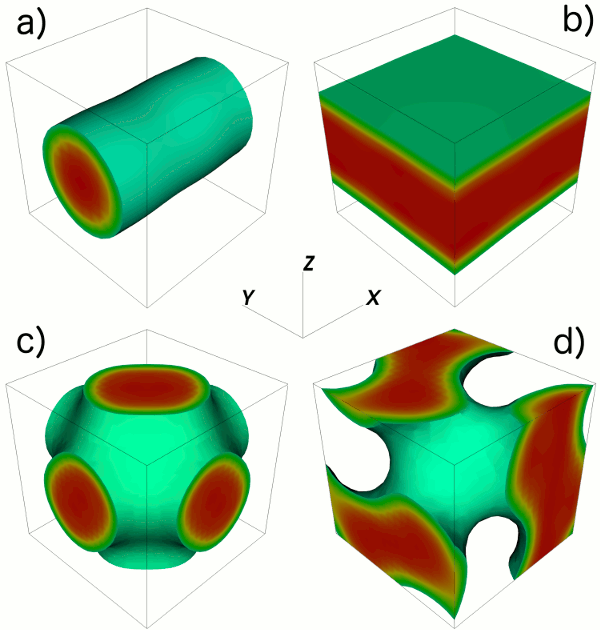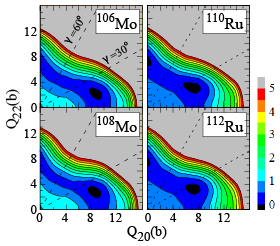Research by Witek Nazarewicz
Heavy Elements from Deep Space
By Witek Nazarewicz
Understanding the origin of elements in nature is one of the outstanding questions in science. A collaboration between two nuclear astrophysicists from Technical University Darmstadt (Germany) – Dirk Martin and Almudena Arcones – and two Michigan State University nuclear physicists – Witold Nazarewicz and Erik Olsen – found that features of nuclear interactions make an imprint on how the heaviest elements in the Universe are created.
The heavy elements in our solar system (such as gold and uranium) are synthesized in stars through a complex chain of nuclear reactions and decays known as the rapid neutron capture process (r-process). This mechanism requires extremely large neutron densities and short-lived exotic isotopes that cannot be produced in today's nuclear laboratories. Currently, the only information about these conditions comes through theoretical models that involve massive extrapolations into areas of the nuclear chart where no experimental information exists. The two leading astrophysical contenders for the site of the r-process are catastrophic supernova explosions and mergers of ultra-dense neutron stars. In our work we predict the yields of elements produced in the r-process for both scenarios using different models of nuclear interactions.
In a paper published in Physical Review Letters 116, 121101 (2016), the collaboration has determined for the first time systematic uncertainties in predicted abundances related to mass modeling for realistic astrophysical scenarios. To facilitate the analysis, the MSU team launched the database massexplorer.frib.msu.edu, which contains theoretical predictions of basic nuclear properties. The outcome of the paper will be helpful for identifying regions of the nuclear chart that are critical for heavy element production. The now under-construction Facility for Rare Isotope Beams at MSU will be a world leader in this area of research and will provide important checks on these predictions.
While we still cannot determine whether the gold in your jewelry or the dysprosium in your hybrid car motor originated from either colliding neutron stars or a supernova explosion, we are closer to understanding their astrophysical origins.

Figure: Abundance distributions predicted in this work for neutron star mergers. The systematic uncertainties are due to variations of the masses predicted in the six nuclear interaction models. The mean predicted abundances are marked by the yellow solid line. Neutron star merger simulation courtesy of Stephan Rosswog.
Predicting Spontaneous Fission Fragment Yields
By Witek Nazarewicz
Spontaneous fission (SF) is a fundamental radioactive decay of very heavy atomic nuclei. In basic science, it is a major driver determining the stability of the heaviest and superheavy elements. Information on SF rates and fission fragment distributions are key ingredients of reaction network calculations aiming at simulating the formation of elements in the universe through nucleosynthesis processes. In the context of the nuclear data program, SF data are also crucial for the calibration of nuclear material counting techniques relevant to international safeguards. For many nuclei of interest, however, experimental data are not available; hence, theory is indispensable to fill in the gaps in nuclear data libraries.
Under the SciDAC NUCLEI program [2] and the Stewardship Science Academic Alliance NNSA program [1], nuclear physicists at Michigan State University and Lawrence Livermore National Laboratory, in a collaboration with Dr. Jhilam Sandhukan from the Variable Energy Cyclotron Centre from Kolkata, have recently made the fist microscopic calculation of spontaneous fission fragment charge and mass distributions of 240Pu [3]. Their novel approach is based on nuclear density functional theory (DFT) – the tool of choice to describe heavy nuclei. Within their model, SF can be viewed as a dynamical two-step process schematically illustrated in Fig. 1. The first phase is represented by a quantum-mechanical tunneling motion through a multidimensional potential energy surface up to the outer turning point. The system then propagates within a classically allowed region before reaching scission, where it finally breaks into two fragments. The key element of the approach is to couple a realistic description of large-amplitude dynamics (including collective dissipation) with a high-fidelity representation of the nuclear potential energy surface.
The collaboration validated their approach on the benchmark case of 240Pu. Using optimized DFT solvers developed during the SciDAC program and high-performance computing facilities at Lawrence Livermore National Laboratory, physicists could generate realistic multi-dimensional potential energy surface for 240Pu. By sampling thousands of fission trajectories obtained from Langevin dynamics from the outer turning point all the way to to scission, the team could reconstruct the distribution of charge and mass of the fission fragments, see Fig. 2. Researchers were encouraged to notice that the predictions remained fairly robust with respect to large changes of parameters describing dissipation. The method presented in this work relies on constructing large collective coordinate spaces using nuclear effective interactions and a microscopic quantum many-body framework. The price one pays for this ambition is computational time: the present calculation of 240Pu took of the order of 15M CPU hours on leadership-class computers. The methodology outlined in this work will be applied to other regions of the nuclear chart to inform research on superheavy elements or the role of fission in the formation of heavy elements in stellar environments.
[1] Theoretical Description of the Fission Process, a project supported by the National Nuclear Security Administration under the Stewardship Science Academic Alliance program through DOE grant DENA0002847, https://people.nscl.msu.edu/˜witek/fission/fission.html.
[2] NUclear Computational Low-Energy Initiative, a SciDAC project funded by the DOE’s Office for Advanced Scientific Computing Research, Office of Nuclear Physics, and National Nuclear Security Administration, http://computingnuclei.org.
[3] J. Sadhukhan,W. Nazarewicz, and N. Schunck, Microscopic modeling of mass and charge distributions in the spontaneous fission of 240 Pu, Phys. Rev. C 93, 011304(R) (2016) http://journals.aps.org/prc/abstract/10.1103/PhysRevC.93.011304
How Much Pasta is Too Much?
By Bastian Schütrumpf and Witek Nazarewicz
Nuclear pasta is present in the inner crust of neutron stars. The pasta phases, named after their intricate shapes that resemble various types of pasta, are explored by theorists through advanced computer simulations. Because the neutron star radius is about 12 km, and pasta occupies a surface layer of about 100 m, the volume of interest is of the order of 100 km^3=10^{11} m^3. Quantum simulations, on the other hand, are carried out in finite volumes containing a few thousand nucleons. The typical volume size considered in simulations is (20 fm)^3 ~ 10^{-41} m^3, hence there is an astronomical mismatch of 52 orders of magnitude between the macroscopic size of the problem and the microscopic size that can be practically computed. To overcome this huge difference, periodic boundary conditions are often assumed, and like bulk materials, pasta is described in terms of small unit cells. Unfortunately, the assumption of periodicity gives rise to artifacts. To overcome the finite-volume spurious effects, we study pasta phases by applying the so-called twist-averaged boundary conditions introduced in the context of metallic systems. We demonstrate that finite-volume effects are reduced significantly by twist averaging. The resulting improvement has made it possible to study the subtle interplay between short-range nuclear forces and long-range Coulomb interaction in complex pasta shapes, including rods, slabs, gyroids, and P-surface shapes.
Like with real pasta, nuclear pasta can be healthy, if served in moderation.

Theory of Rotating Triaxial Nuclei
by C. L. Zhang and W. Nazarewicz
Atomic nuclei come in all different shapes and sizes. Some are shaped like softballs, others like footballs, and some are so oddly configured that their three axes all have different lengths (not unlike a football that has been hit with a hammer). The existence of nuclei with triaxial shape deformations has been a topic of active research since the early 1950s. So far, there has been no clear evidence for nuclei that are triaxial in their ground states, and theoretical calculations predict very few such candidates, with fairly small energy gains due to triaxiality. However, the evidence for existence of static triaxial shapes still remains scarce.
According to theory, good prospects for low-spin triaxiality exist in the neutron-rich Mo-Ru region. Experimentally, the clearest signature of triaxial shapes comes from the ã-ray spectroscopy of rotating nuclei. Recently, transition quadrupole moments in rotational bands of even-mass isotopes of molybdenum and ruthenium nuclei have been measured with Gammasphere at ANL [1]. The new data have provided a challenge for theoretical descriptions invoking stable triaxial deformations. Indeed, as concluded in Ref. [1]: “Attempts to describe the observations in mean-field based models (…) illustrate the challenge theory faces and the difficulty to infer information on γ -softness and triaxiality from the data.”
To shed some light on this puzzle, and to further explore the importance of triaxial deformation in this mass region, we carried out a theoretical analysis [2] of moments of inertia, shapes, and transition quadrupole moments in nuclei around 110Ru using nuclear density functional theory (DFT) with the recently optimized energy density functional UNEDF0. To explore the variety of nuclear shapes at low and high angular momenta, we used the symmetry-unrestricted DFT solver HFODD. Our self-consistent DFT results were compared with predictions of the triaxial projected shell model. We predict triaxial ground-state deformations in 106,108Mo and 108,110,112Ru and reproduce the observed low-frequency behavior of moments of inertia. The computed transition quadrupole moments vary with angular momentum, which reflects deformation changes with rotation; those variations are consistent with experiment. Our results obtained with the triaxial projected shell model and the DFT approach paint the same picture, and strongly favor the triaxial interpretation. Thus, we conclude that the structure of neutron-rich even-even nuclei around 110Ru is consistent with triaxial shapes. This work constitutes a part of Ph.D. project of Chunli Zhang.
[1] J. Snyder et al., Phys. Lett. B 723, 61 (2013).
[2] C.L. Zhang et al., Phys. Rev. C 92, 034307 (2015)

Fig. 1: Calculated potential energy surface in the quadrupole moment plane (Q20,Q22) for 106,108Mo and 110,112Ru. The difference between contour lines is 0.5 MeV.

Fig. 2: Transition quadrupole moments for 106,108Mo and 108,110,112Ru as functions of rotational frequency calculated in this work [2] compared to experiment [1].



